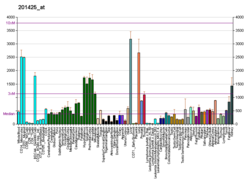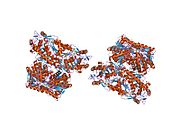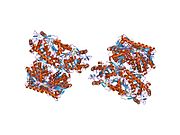ALDH2
| ALDH2 | |||||||||||||||||||||||||||||||||||||||||||||||||||
|---|---|---|---|---|---|---|---|---|---|---|---|---|---|---|---|---|---|---|---|---|---|---|---|---|---|---|---|---|---|---|---|---|---|---|---|---|---|---|---|---|---|---|---|---|---|---|---|---|---|---|---|
| |||||||||||||||||||||||||||||||||||||||||||||||||||
| Identifiers | |||||||||||||||||||||||||||||||||||||||||||||||||||
| Aliases | ALDH2,ALDH-E2, ALDHI, ALDM, aldehyde dehydrogenase 2 family (mitochondrial), aldehyde dehydrogenase 2 family member | ||||||||||||||||||||||||||||||||||||||||||||||||||
| External IDs | OMIM:100650;MGI:99600;HomoloGene:55480;GeneCards:ALDH2;OMA:ALDH2 - orthologs | ||||||||||||||||||||||||||||||||||||||||||||||||||
| |||||||||||||||||||||||||||||||||||||||||||||||||||
| |||||||||||||||||||||||||||||||||||||||||||||||||||
| |||||||||||||||||||||||||||||||||||||||||||||||||||
| |||||||||||||||||||||||||||||||||||||||||||||||||||
| Wikidata | |||||||||||||||||||||||||||||||||||||||||||||||||||
| |||||||||||||||||||||||||||||||||||||||||||||||||||
Aldehyde dehydrogenase, mitochondrialis anenzymethat in humans is encoded by theALDH2genelocated onchromosome 12.[5][6]ALDH2 belongs to thealdehyde dehydrogenasefamily of enzymes. Aldehyde dehydrogenase is the second enzyme of the majoroxidativepathway ofalcoholmetabolism. ALDH2 has a lowKmforacetaldehyde,and is localized inmitochondrial matrix.The other liver isozyme,ALDH1,localizes to thecytosol.[7]
MostWhite peoplehave both major isozymes, while approximately 36% ofEast Asianshave the cytosolic isozyme but not a functional mitochondrial isozyme. A remarkably higher frequency ofacute alcohol intoxicationamong East Asians than among Whites could be related to this absence of acatalyticallyactive form of ALDH2. The increased exposure to acetaldehyde in individuals with the catalytically inactive form may also confer greater susceptibility to many types ofcancer.[8]
Gene
[edit]TheALDH2gene is about 44kbpin length and contains at least 13exonswhichencode517amino acidresidues. Except for thesignal NH2-terminal peptide,which is absent in the mature enzyme, the amino acid sequence deduced from the exons coincided with the reportedprimary structureof human liver ALDH2. SeveralintronscontainAlurepetitive sequences. ATATA-like sequence (TTATAAAA) and aCAAT-like sequence (GTCATCAT) are located 473 and 515bp,respectively,upstreamfrom thetranslation initiation codon.[9]
Enzyme structure
[edit]ALDH2 is atetramericenzyme that contains three domains; two dinucleotide-binding domains and a three-stranded beta-sheet domain. The active site of ALDH2 is divided into two halves by the nicotinamide ring ofnicotinamide adenine dinucleotide(NAD+). Adjacent to the A-side (Pro-R) of thenicotinamidering is a cluster of threecysteines(Cys301, Cys302 and Cys303) and adjacent to the B-side (Pro-S) areThr244,Glu268, Glu476 and an ordered water molecule bound to Thr244 and Glu476.[10]Although there is a recognizableRossmann fold,the coenzyme-binding region of ALDH2 binds NAD+in a manner not seen in other NAD+-binding enzymes. The positions of the residues near the nicotinamide ring of NAD+suggest a chemical mechanism whereby Glu268 functions as ageneral basethrough a bound water molecule. The sidechain amide nitrogen ofAsn169 and the peptide nitrogen of Cys302 are in position to stabilize the oxyanion present in the tetrahedraltransition stateprior tohydridetransfer. The functional importance of residue Glu487 now appears to be due to indirect interactions of this residue with the substrate-binding site viaArg264 and Arg475.[11]
Function
[edit]Mitochondrial aldehyde dehydrogenase belongs to thealdehyde dehydrogenasefamily of enzymes that catalyze the chemical transformation fromacetaldehydetoacetic acid.Aldehyde dehydrogenase is the second enzyme of the major oxidative pathway of alcohol metabolism. Human ALDH2 is especially efficient on acetaldehyde compared to ALDH1.[12]

Additionally, ALDH2 functions as a protector againstoxidative stress.[13]
Genetic variation
[edit]| SNP: ALDH2*2 | |
|---|---|
| Name(s) | g.42421G>A, Glu504Lys |
| Gene | ALDH2 |
| Chromosome | 12 |
| Region | Exon |
| External databases | |
| Ensembl | Human SNPView |
| dbSNP | 671 |
| HapMap | 671 |
| SNPedia | 671 |
The inactivating ALDH2*2 mutation is "the most common single point mutation in humans".[14]This mutation is found in very few White people, but about 50% of East Asians areheterozygousfor this mutation. The ALDH2*2alleleencodeslysineinstead ofglutamic acidatamino acid487,[15]distorting the NAD+ binding site.[16][17]ALDH2 assembles and functions as atetramerand requires all four of its components to be active in order to metabolize acetaldehyde. People heterozygous for ALDH2*2 have only 10% to 45% enzyme activity, while those homozygous for ALDH2*2 have as little as 1% to 5% remaining activity.[18]
The lack of ALDH2 activity has a number of consequences, detailed in section§ Inhibition and genetic deficiencybelow.
Distribution
[edit]In the overall Japanese population, about 57% of individuals arehomozygousfor the normal allele, 40% areheterozygousfor the ALDH2*2 allele, and 3% are homozygous for the ALDH2*2 allele.[15]
Clinical significance
[edit]Inhibition and genetic deficiency
[edit]Alcohol metabolism
[edit]The best-known consequence of ALDH2 dysfunction is in relation to the consumption ofethanol.People heterozygous or homozygous for the ALDH2*2 metabolize ethanol to acetaldehyde normally but metabolize acetaldehyde poorly. As a result, they accumulate increased levels of acetaldehyde after consumption ofalcoholic beverages.Effects include facial flushing (i.e. the "Alcohol flush reaction"),urticaria,systemicdermatitis,andalcohol-induced respiratory reactionssuch asrhinitisand the exacerbation ofasthmabronchoconstriction.[19]The cited allergic reaction-like symptoms: (a) do not appear due to classicalIgEorT cell-relatedallergen-induced reactions but rather the actions of acetaldehyde in stimulating the release ofhistamine,a probable mediating cause of these symptoms; (b) typically occur within 30–60 minutes of ingesting alcoholic beverages; and (c) occur in other Asian as well as non-Asian individuals that are either seriously defective in metabolizing ingested ethanol past acetaldehyde to acetic acid or, alternatively, that metabolize ethanol too rapidly for ALDH2 processing.[19][20]
People with a genetic ALDH2*2 deficiency have historically had a lower likelihood of developing alcoholism, both from stronger adverse effects and a possible reduction of dopamine release.[21]However, this effect is not absolute: during the 1980s, there has been a steady increase in the number of Japanese alcoholics who carry the ALDH2*2 mutation. A strong social pressure to drink have overcome this genetic barrier toalcoholism.[22]Disulfiram, which inhibits ALDH2 and causes a similar effect, has been used as an alcohol-quitting aid.[21]
Various conditions
[edit]More recently, ALDH2 has been implicated in a number of pathways beyond alcohol metabolism. ALDH2 dysfunction is supposedly associated with a variety of human diseases including diabetes, neurodegenerative diseases, cardiovascular diseases and stroke, cancer, Fanconi anemia, pain, osteoporosis, and the process of aging.[14]The inactivating ALDH2 rs671 polymorphism, present in up to 8% of the global population and in up to 50% of the East Asian population, is associated with increased risk of cardiovascular conditions such as coronary artery disease, alcohol-induced cardiac dysfunction, pulmonary arterial hypertension, heart failure and drug-induced cardiotoxicity.[23]
Alzheimer's disease
[edit]A case-control study in a Japanese population showed that deficiency of ALDH2 activity influences the risk for late-onsetAlzheimer's disease.[13]The ALDH2knockout micedisplay age-related memory deficits in various tasks, as well as endothelial dysfunction, brain atrophy, and other Alzheimer's disease-associated pathologies, including marked increases inlipid peroxidationproducts,amyloid-beta,p-tauand activatedcaspases.These behavioral and biochemical Alzheimer's disease-like deficits were efficiently ameliorated when these mice were treated withisotope-reinforced lipids(deuterated polyunsaturated fatty acids).[24]
Activation
[edit]An activator of ALDH2 enzymatic activity,Alda-1(N-(1,3-benzodioxol-5-ylmethyl)-2,6-dichlorobenzamide), has been shown to reduceischemia-induced cardiac damage caused bymyocardial infarction.[25]
Interactions
[edit]ALDH2 has been shown tointeractwithGroEL.[26]
See also
[edit]- Acetaldehyde dehydrogenase
- Alcohol dehydrogenase
- Alcohol flush reaction
- Alcohol-induced respiratory reactions
References
[edit]- ^abcGRCh38: Ensembl release 89: ENSG00000111275–Ensembl,May 2017
- ^abcGRCm38: Ensembl release 89: ENSMUSG00000029455–Ensembl,May 2017
- ^"Human PubMed Reference:".National Center for Biotechnology Information, U.S. National Library of Medicine.
- ^"Mouse PubMed Reference:".National Center for Biotechnology Information, U.S. National Library of Medicine.
- ^Yoshida A, Ikawa M, Hsu LC, Tani K (1985). "Molecular abnormality and cDNA cloning of human aldehyde dehydrogenases".Alcohol.2(1): 103–6.doi:10.1016/0741-8329(85)90024-2.PMID4015823.
- ^Hsu LC, Tani K, Fujiyoshi T, Kurachi K, Yoshida A (Jun 1985)."Cloning of cDNAs for human aldehyde dehydrogenases 1 and 2".Proceedings of the National Academy of Sciences of the United States of America.82(11): 3771–5.Bibcode:1985PNAS...82.3771H.doi:10.1073/pnas.82.11.3771.PMC397869.PMID2987944.
- ^"Entrez Gene: ALDH2 aldehyde dehydrogenase 2 family (mitochondrial)".
- ^Seitz HK, Meier P (2007). "The role of acetaldehyde in upper digestive tract cancer in alcoholics".Transl Res.149(6): 293–7.doi:10.1016/j.trsl.2006.12.002.PMID17543846.
- ^Hsu LC, Bendel RE, Yoshida A (Jan 1988). "Genomic structure of the human mitochondrial aldehyde dehydrogenase gene".Genomics.2(1): 57–65.doi:10.1016/0888-7543(88)90109-7.PMID2838413.
- ^González-Segura L, Ho KK, Perez-Miller S, Weiner H, Hurley TD (Feb 2013)."Catalytic contribution of threonine 244 in human ALDH2".Chemico-Biological Interactions.202(1–3): 32–40.Bibcode:2013CBI...202...32G.doi:10.1016/j.cbi.2012.12.009.PMC3602351.PMID23295226.
- ^Steinmetz CG, Xie P, Weiner H, Hurley TD (May 1997)."Structure of mitochondrial aldehyde dehydrogenase: the genetic component of ethanol aversion".Structure.5(5): 701–11.doi:10.1016/s0969-2126(97)00224-4.PMID9195888.
- ^Wang MF, Han CL, Yin SJ (16 March 2009). "Substrate specificity of human and yeast aldehyde dehydrogenases".Chemico-Biological Interactions.178(1–3): 36–9.Bibcode:2009CBI...178...36W.doi:10.1016/j.cbi.2008.10.002.PMID18983993.
- ^abOhta S, Ohsawa I, Kamino K, Ando F, Shimokata H (Apr 2004). "Mitochondrial ALDH2 deficiency as an oxidative stress".Annals of the New York Academy of Sciences.1011(1): 36–44.Bibcode:2004NYASA1011...36O.doi:10.1196/annals.1293.004.PMID15126281.S2CID28571902.
- ^abChen CH, Ferreira JC, Gross ER, Mochly-Rosen D (2014)."Targeting Aldehyde Dehydrogenase 2: New Therapeutic Opportunities".Physiological Reviews.94(1): 1–34.doi:10.1152/physrev.00017.2013.PMC3929114.PMID24382882.
- ^abTakao A, Shimoda T, Kohno S, Asai S, Harda S (May 1998)."Correlation between alcohol-induced asthma and acetaldehyde dehydrogenase-2 genotype".The Journal of Allergy and Clinical Immunology.101(5): 576–80.doi:10.1016/S0091-6749(98)70162-9.PMID9600491.
- ^Larson HN, Weiner H, Hurley TD (August 2005)."Disruption of the coenzyme binding site and dimer interface revealed in the crystal structure of mitochondrial aldehyde dehydrogenase" Asian "variant".The Journal of Biological Chemistry.280(34): 30550–6.doi:10.1074/jbc.M502345200.PMC1262676.PMID15983043.
- ^Chang HY, Mitchell A (May 2014)."Dionysian Mysteries The Aldehyde Dehydrogenase (aldh) Family".InterPro Protein Focus.
- ^Ma C, Yu B, Zhang W, Wang W, Zhang L, Zeng Q (11 September 2017)."Associations between aldehyde dehydrogenase 2 (ALDH2) rs671 genetic polymorphisms, lifestyles and hypertension risk in Chinese Han people".Scientific Reports.7(1): 11136.Bibcode:2017NatSR...711136M.doi:10.1038/s41598-017-11071-w.PMC5593832.PMID28894224.
- ^abAdams KE, Rans TS (Dec 2013). "Adverse reactions to alcohol and alcoholic beverages".Annals of Allergy, Asthma & Immunology.111(6): 439–45.doi:10.1016/j.anai.2013.09.016.PMID24267355.
- ^Linneberg A, Gonzalez-Quintela A, Vidal C, Jørgensen T, Fenger M, Hansen T, Pedersen O, Husemoen LL (Jan 2010). "Genetic determinants of both ethanol and acetaldehyde metabolism influence alcohol hypersensitivity and drinking behaviour among Scandinavians".Clinical and Experimental Allergy.40(1): 123–30.doi:10.1111/j.1365-2222.2009.03398.x.PMID20205700.S2CID40246805.
- ^abChen CH, Ferreira JC, Gross ER, Mochly-Rosen D (2014)."Targeting Aldehyde Dehydrogenase 2: New Therapeutic Opportunities".Physiological Reviews.94(1): 1–34.doi:10.1152/physrev.00017.2013.PMC3929114.PMID24382882.
- ^Higuchi S, Matsushita S, Imazeki H, Kinoshita T, Takagi S, Kono H (March 1994). "Aldehyde dehydrogenase genotypes in Japanese alcoholics".Lancet.343(8899): 741–2.doi:10.1016/S0140-6736(94)91629-2.PMID7907720.S2CID41404745.
- ^Zhang J, Guo Y, Zhao X, Pang J, Pan C, Wang J, Wei S, Yu X, Zhang C, Chen Y, Yin H, Xu F (2023)."The role of aldehyde dehydrogenase 2 in cardiovascular disease".Nature Reviews. Cardiology.20(7): 495–509.doi:10.1038/s41569-023-00839-5.PMID36781974.S2CID256845243.
- ^Elharram A, Czegledy NM, Golod M, Milne GL, Pollock E, Bennett BM, Shchepinov MS (December 2017)."Deuterium-reinforced polyunsaturated fatty acids improve cognition in a mouse model of sporadic Alzheimer's disease".The FEBS Journal.284(23): 4083–4095.doi:10.1111/febs.14291.PMC5716852.PMID29024570.
- ^Chen CH, Budas GR, Churchill EN, Disatnik MH, Hurley TD, Mochly-Rosen D (Sep 2008)."Activation of aldehyde dehydrogenase-2 reduces ischemic damage to the heart".Science.321(5895): 1493–5.Bibcode:2008Sci...321.1493C.doi:10.1126/science.1158554.PMC2741612.PMID18787169.
- ^Lee KH, Kim HS, Jeong HS, Lee YS (Oct 2002). "Chaperonin GroESL mediates the protein folding of human liver mitochondrial aldehyde dehydrogenase in Escherichia coli".Biochemical and Biophysical Research Communications.298(2): 216–24.doi:10.1016/S0006-291X(02)02423-3.PMID12387818.
Further reading
[edit]- Yoshida A (1992). "Molecular genetics of human aldehyde dehydrogenase".Pharmacogenetics.2(4): 139–47.doi:10.1097/00008571-199208000-00001.PMID1306115.
- Chao YC, Liou SR, Tsai SF, Yin SJ (1993). "Dominance of the mutant ALDH2(2) allele in the expression of human stomach aldehyde dehydrogenase-2 activity".Proc. Natl. Sci. Counc. Repub. China B.17(3): 98–102.PMID8290656.
- Crabb DW, Edenberg HJ, Bosron WF, Li TK (1989)."Genotypes for aldehyde dehydrogenase deficiency and alcohol sensitivity. The inactive ALDH2(2) allele is dominant".J. Clin. Invest.83(1): 314–6.doi:10.1172/JCI113875.PMC303676.PMID2562960.
- Hsu LC, Bendel RE, Yoshida A (1988). "Genomic structure of the human mitochondrial aldehyde dehydrogenase gene".Genomics.2(1): 57–65.doi:10.1016/0888-7543(88)90109-7.PMID2838413.
- Hsu LC, Tani K, Fujiyoshi T, Kurachi K, Yoshida A (1985)."Cloning of cDNAs for human aldehyde dehydrogenases 1 and 2".Proc. Natl. Acad. Sci. U.S.A.82(11): 3771–5.Bibcode:1985PNAS...82.3771H.doi:10.1073/pnas.82.11.3771.PMC397869.PMID2987944.
- Braun T, Grzeschik KH, Bober E, Singh S, Agarwal DP, Goedde HW (1986). "The structural gene for the mitochondrial aldehyde dehydrogenase maps to human chromosome 12".Hum. Genet.73(4): 365–7.doi:10.1007/BF00279102.PMID3017845.S2CID28795641.
- Braun T, Bober E, Singh S, Agarwal DP, Goedde HW (1987)."Isolation and sequence analysis of a full length cDNA clone coding for human mitochondrial aldehyde dehydrogenase".Nucleic Acids Res.15(7): 3179.doi:10.1093/nar/15.7.3179.PMC340920.PMID3562250.
- Braun T, Bober E, Singh S, Agarwal DP, Goedde HW (1987)."Evidence for a signal peptide at the amino-terminal end of human mitochondrial aldehyde dehydrogenase".FEBS Lett.215(2): 233–6.doi:10.1016/0014-5793(87)80152-7.PMID3582651.S2CID42627599.
- Agarwal DP, Goedde HW (1987). "Human aldehyde dehydrogenase isozymes and alcohol sensitivity".Isozymes Curr. Top. Biol. Med. Res.16:21–48.PMID3610592.
- Hempel J, Höög JO, Jörnvall H (1987). "Mitochondrial aldehyde dehydrogenase. Homology of putative targeting sequence to that of carbamyl phosphate synthetase I revealed by correlation of cDNA and protein data".FEBS Lett.222(1): 95–8.doi:10.1016/0014-5793(87)80198-9.PMID3653404.S2CID33980993.
- Yoshida A, Ikawa M, Hsu LC, Tani K (1985). "Molecular abnormality and cDNA cloning of human aldehyde dehydrogenases".Alcohol.2(1): 103–6.doi:10.1016/0741-8329(85)90024-2.PMID4015823.
- Hempel J, Kaiser R, Jörnvall H (1985)."Mitochondrial aldehyde dehydrogenase from human liver. Primary structure, differences in relation to the cytosolic enzyme, and functional correlations".Eur. J. Biochem.153(1): 13–28.doi:10.1111/j.1432-1033.1985.tb09260.x.PMID4065146.
- Yoshida A, Huang IY, Ikawa M (1984)."Molecular abnormality of an inactive aldehyde dehydrogenase variant commonly found in Orientals".Proc. Natl. Acad. Sci. U.S.A.81(1): 258–61.Bibcode:1984PNAS...81..258Y.doi:10.1073/pnas.81.1.258.PMC344651.PMID6582480.
- Xiao Q, Weiner H, Johnston T, Crabb DW (1995)."The aldehyde dehydrogenase ALDH2*2 allele exhibits dominance over ALDH2*1 in transduced HeLa cells".J. Clin. Invest.96(5): 2180–6.doi:10.1172/JCI118272.PMC185867.PMID7593603.
- Maruyama K, Sugano S (1994). "Oligo-capping: a simple method to replace the cap structure of eukaryotic mRNAs with oligoribonucleotides".Gene.138(1–2): 171–4.doi:10.1016/0378-1119(94)90802-8.PMID8125298.
- Novoradovsky A, Tsai SJ, Goldfarb L, Peterson R, Long JC, Goldman D (1995). "Mitochondrial aldehyde dehydrogenase polymorphism in Asian and American Indian populations: detection of new ALDH2 alleles".Alcohol. Clin. Exp. Res.19(5): 1105–10.doi:10.1111/j.1530-0277.1995.tb01587.x.PMID8561277.
- Xiao Q, Weiner H, Crabb DW (1996)."The mutation in the mitochondrial aldehyde dehydrogenase (ALDH2) gene responsible for alcohol-induced flushing increases turnover of the enzyme tetramers in a dominant fashion".J. Clin. Invest.98(9): 2027–32.doi:10.1172/JCI119007.PMC507646.PMID8903321.
External links
[edit]- ALDH2 protein, humanat the U.S. National Library of MedicineMedical Subject Headings(MeSH)
- HumanALDH2genome location andALDH2gene details page in theUCSC Genome Browser.






















